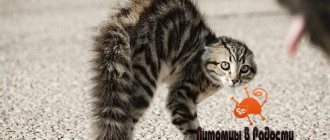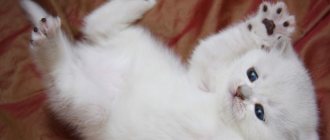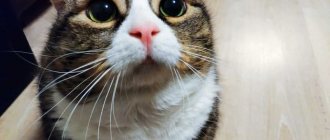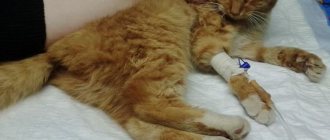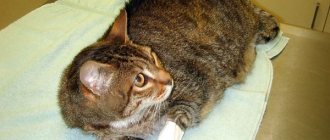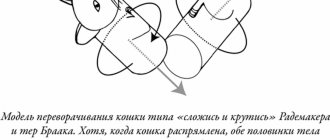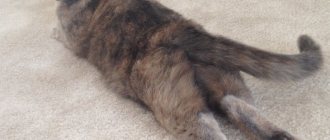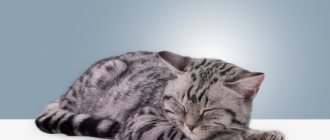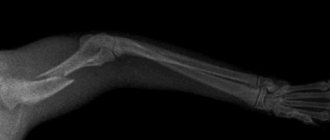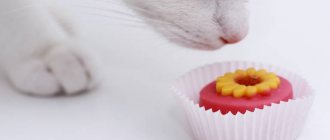A New York veterinary hospital keeps the medical history of the cat Sabrina, who, after falling from the 32nd floor, remained alive with a broken tooth and other minor injuries. At first glance, this fantastic story is not so surprising and certainly not unique.
If a person falls from a great height, he usually receives severe injury - fractures of the skull and spine, and severe internal bleeding may develop. It is rare that anyone survives a fall from a height of several floors.
How cats land on their feet
The question of cats falling has occupied physicists for a long time. Several approximate models have been proposed that could explain how cats manage to land on their feet. Scientists have come to the conclusion that this is, after all, a reflex, and not a special calculation of rotation at the beginning of the fall, as was commonly thought before. Here's what helps cats land safely:
- An excellently developed vestibular apparatus that controls the position of the body in space;
- When falling, cats spread their paws, increasing the surface area of their body, thereby turning into a small “parachute.” The falling speed does not exceed 100 km/h, regardless of the height from which the animal falls;
- To roll over, the cat first straightens its head and then bends its body in the middle. After which it turns over 180⁰ along its axis and again changes the bend of the body, compensating for the angular momentum that arises during rotation. Both halves of the body rotate, most likely synchronously. That is, the body bends, but does not twist;
- Before falling, the hind legs are aligned according to the position of the front ones;
- Before landing, cats arch their backs slightly and bend their paws so that the force of the blow is distributed across the tendons and muscles, softening the landing;
- The muscles of cats act as an excellent shock absorber, since in relation to the total body weight they are stronger than, for example, in humans.
By the way, according to research, when cats fall from a very high height, they still land not on their paws, but on their stomach. And tailless cats move in flight in the same way as tailed ones. Only for proper grouping they use their hind legs more. Deaf cats fall just as well as healthy ones, but blind cats behave less actively when falling.
Read also: Why the rose does not bloom in the garden
"Falling Skater"
The French mathematician of the 17th-18th centuries, Antoine Paran, and after him James Clerk Maxwell, believed that a cat, which is already spinning at the moment of falling, can change the speed of its rotation by pulling or extending the full length of its paw, which changes its overall moment inertia. The explanation was already recorded in detail by William Gordon Stables.
“At the beginning of a fall from a height, the cat’s back is curved in a semicircle. Natural instinct prompts her, after she has flown a foot or two, to suddenly contract the muscles of her back and extend her paws; now her stomach arches and her back becomes concave, which changes the center of gravity and turns her body over; After this, the cat, in order to land on its paws, can only hold itself in this position.”
This explanation does not seem to be true: a cat in free fall is not attached to anything, which means that changing the position of its body does not affect its stability in any way. Additionally, scientists couldn't really notice all of the animal's movements because cats roll over too quickly. But soon photography came to the aid of people.
Cats in space
In the 1950-60s, during experiments to prepare for the launch of animals and humans into space, the behavior of cats in zero gravity was studied. It turned out that in zero gravity cats do not roll over, since there is no gravity there. Upon returning to the gravity field, the cat may roll over if it has spent no more than five seconds in weightlessness. Otherwise, the proportion of successful rollovers fell.
Thomas Kane, a professor of engineering mathematics at Stanford University, applied his mathematical methods to the falling cat problem. He created the most accurate model to date, which combines the Rademaker and Marey hypotheses. The study of cat movement was used to teach astronauts how to effectively change their body position in zero gravity.
Complex reflex
Equally important was the question of how the animal's brain controls the body's muscles to turn the cat over correctly. In 1916, Lewis Weed of Johns Hopkins University and his colleague Henry Mueller conducted the first neurobiological study of the cat reflex. They were not interested in the specific movements of the cat, but in how the nervous system initiates these movements.
The species “turned off” the cat’s cerebral hemispheres from the process - and saw that a cat lacking cerebral hemispheres does not exhibit a rollover reflex. This suggested that consciousness was required to flip in the air. In addition, Müller and Weed tried to understand how a cat determines which way to turn in order to land on its paws. They found that a blindfolded cat is able to roll over and land in the correct position, and a cat with a damaged vestibular system but functioning vision can do the same. But if you blindfold a cat and at the same time damage its vestibular apparatus, the cat will not even try to roll over. This means that the rollover reflex relies either on vision or on the sense of balance.
How do cats survive falling from great heights?
In addition to the ability to group, cats have a number of advantages that nature has endowed them with:
1. Skeleton. Flexible, lightweight bones coupled with their small size help cats remain more protected than other animals and people when falling from heights.
2. Resistance. Terminal velocity is the maximum speed an object reaches as it falls. It can be reduced by increasing drag, which is air resistance that can slow an object down. Cats have increased resistance due to the way they move their limbs when falling. Also resistance increases wool. This is why furry cats are more protected when falling from a height.
3. Paws. A cat's paws are strong and muscular. They help cats move unnoticed and also soften falls by acting as shock absorbers. The force of the blow is distributed between the four limbs and allows you to protect the body.
4. Tail. It can help stabilize the body when falling. Short-tailed and tailless cats do not have this advantage, but this does not affect the righting reflex itself.
Fall Prevention
Mosquito nets do not help keep a cat out of a window. They are absolutely useless and only protect against mosquitoes. These nets do not stick well to the window and are easily torn. If the cat needs it, it will jump out in no time.
Don’t rely on plastic windows with ventilation mode. This doesn't save cats. They often get stuck between the frames, receiving damage no less terrible than if they fell.
Article continues after advertisement
Instead of all this, special metal meshes were invented for cats. They are attached to the window very securely and do not tear. Cats can even jump and hang on them. Therefore, if you have a tailed friend living at home, such a net is vital.
Landing mechanism
Experiments with cats falling were carried out two centuries ago by French researchers. They changed the height, released the cat and analyzed its movements. For a long time it was believed that the tail was responsible for landing on four paws, because it was considered a kind of rudder. But later it turned out that even without a tail, the cat always lands on its paws.
Regardless of the position in which the fall begins, in a very short time the cat's body turns around and aligns itself with the ground. In more detail it looks like this
"Push up and turn around"
Physician and photographer Etienne-Jules Marey recorded all stages of a cat's fall in photographs. When the French Academy saw these photos, they couldn’t believe their eyes. How can a cat turn itself half a turn without a support point? Maybe she was pushing off from the window sill or the hand that dropped her? But no, Marey's photographs clearly showed that the revolution begins only when the cat is already in free flight and does not have any objects nearby from which it could push off.
Mathematician Emile Guillou proposed the following model of what is happening: a cat, with the help of its front and hind legs, controls the moment of inertia of the front and rear parts of the body. First, he stretches out his hind legs and picks up his front legs (and now the upper part is already correctly oriented), then he picks up his hind legs, stretches out his front legs and “twists” the lower part to the correct orientation, without turning the upper part, which is already in the correct position.
Spine
Flying kittens
In addition to muscles, successful flight also depends on the flexibility of the joints of the spine. A cat, unlike a person, has a large number of spinal links (a cat has thirty of them, while a person has 24). This makes the cat's spine elastic, and that is why the animal can so elegantly and gracefully arch its back in a way that a person is not able to do.
A remarkably developed vestibular apparatus allows a cat that falls to the ground to navigate its surroundings, intuitively assess its own chances and bring its body into the most favorable position for landing.
A cat is a fairly small and light animal. Its weight relative to the area of the body is much less than that of a person. This also contributes to the ability to correctly group the torso.
"Tail-propeller"
Mathematician Giuseppe Peano proposed a different mechanism: the cat twists its body, rotating its tail like a propeller. Having turned to the desired angle, the cat stops its tail, and thereby its own rotational movement, saving at the same time the essence and principle of areas. A cat's tail, however, weighs much less than itself, which means that the tail will have to make more than one revolution to turn the entire body over.
However, almost a century later, in 1989, J. E. Frederickson experimentally demonstrated that a tailless cat is perfectly capable of rolling over, although cats that do have tails do use them to aid the process.
Possible consequences
Independent experiments with cat abilities are fraught with dangerous consequences. You should not intentionally release an animal from a great height, otherwise instead of a successful landing, disaster may happen in front of the owner’s eyes :
- traumatic brain injuries;
- ruptures of internal organs;
- fractures, dislocations;
- hematomas, lacerations;
- shock.
Older animals often have problems with the musculoskeletal system, so for them a fall from a height can be fatal. But all negative circumstances are nothing more than an exception. Every cat, 3-4 weeks after birth, a priori knows how to land correctly.
Every person, at least once in his life, wonders why cats land on their paws? Despite the fact that this phenomenon is easily explained in terms of the physiology of the cat family, for most people it is nothing more than a unique and inimitable ability. Cats are amazing animals that will never cease to amaze and captivate humanity.
Previous
Question and answer Normal creatinine levels in urine in cats
Next
Question and answer: Can cats swim?
Great article
Associated symptoms
Symptoms of diseases can develop in two ways. In the first case it manifests itself immediately and in full, and in the second it manifests itself gradually with an intensifying effect. In any situation, you need to seek help from a specialist as soon as possible. Among the most common symptoms are:
- unsteady gait;
- falling on one side when walking;
- inability to move quickly;
- lack of coordination;
- uncertain behavior in space;
- fear of making a movement;
- gently stepping on one side of the paws;
- pupils of different sizes;
- shifty eyes;
- fainting;
- inadequate reaction to habitual actions;
- With epilepsy, the jaws involuntarily close, convulsions, and involuntary urination.
This behavior is justified by the animal’s fear of falling, dizziness, pain in the brain and heart, as well as in the limbs. The development of paralysis can begin as a result of damage to the body by infection, or an inflammatory process in internal organs and systems, when blood flow is disrupted. If parts of the spinal column are disturbed, then the owners often note a disturbance in the bowel movements of the bladder and intestines. The development of ataxia can be facilitated by a brain tumor, panleukopenia, chemical poisoning, and skull trauma.
Treatment is prescribed only by a veterinarian based on the diagnosis. In some cases, the animal will be indicated for inpatient treatment with injections and droppers.
